Key takeaways:
- React offers a component-based architecture and virtual DOM for optimized performance, making it suitable for complex and highly interactive applications.
- Vue is recognized for its simplicity, reactivity system, and single-file components, allowing for gradual integration and quick prototyping, especially in smaller projects.
- Choosing between React and Vue depends on project complexity, team familiarity, and individual developer preferences, highlighting the importance of aligning the framework with project goals.
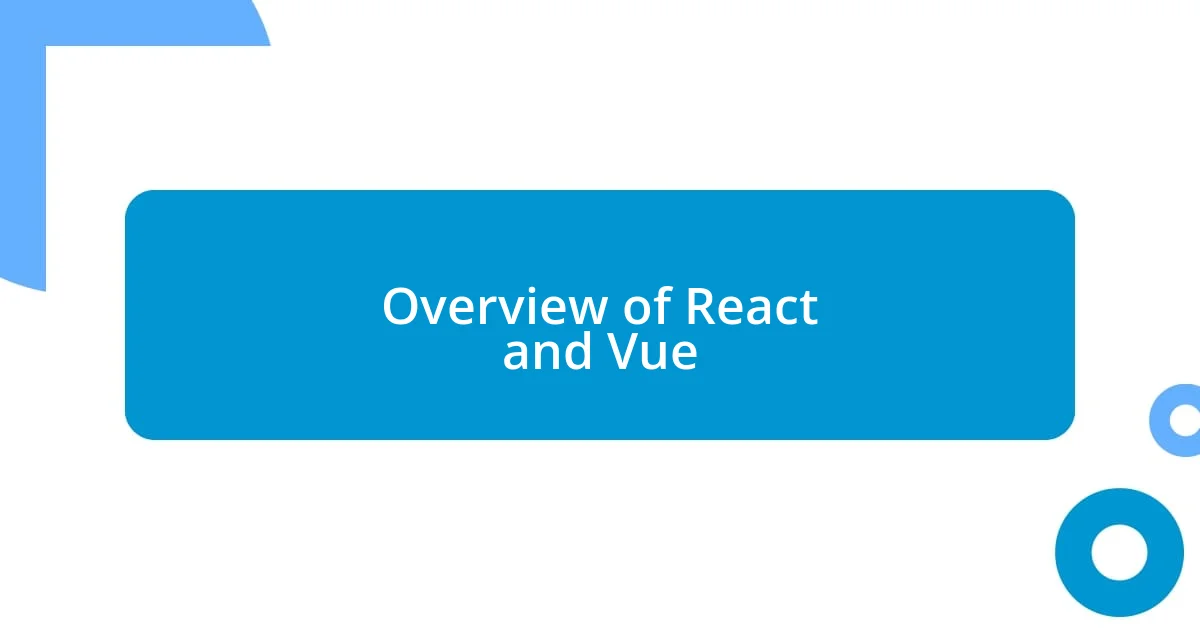
Overview of React and Vue
React, developed by Facebook, is a powerful JavaScript library designed for building user interfaces, especially for single-page applications. I remember the first time I tackled a React project; the component-based architecture was a game changer for me, making it easy to reuse code and keep my application organized. Have you ever found yourself tangled in a web of HTML and JavaScript? React’s JSX syntax, which allows you to write HTML within JavaScript, can feel like a breath of fresh air.
On the flip side, Vue is often praised for its simplicity and ease of integration. When I dived into Vue, it felt like a warm hug compared to the complexities I faced with other frameworks. It’s designed to be incrementally adaptable, which is perfect if you’re looking to enhance existing projects gradually. Have you ever felt overwhelmed trying to implement a new framework all at once? Vue makes this process remarkably smooth by allowing you to introduce its features one step at a time.
Both frameworks have passionate communities and plenty of resources, which can be comforting when you’re learning something new. I still fondly remember the late nights spent poring over React documentation and forums, seeking solutions to those pesky bugs that appeared out of nowhere. The support from fellow developers not only enhanced my skills but also deepened my appreciation for the power of community in tech. Don’t you think having that sense of belonging can make a world of difference in your coding journey?
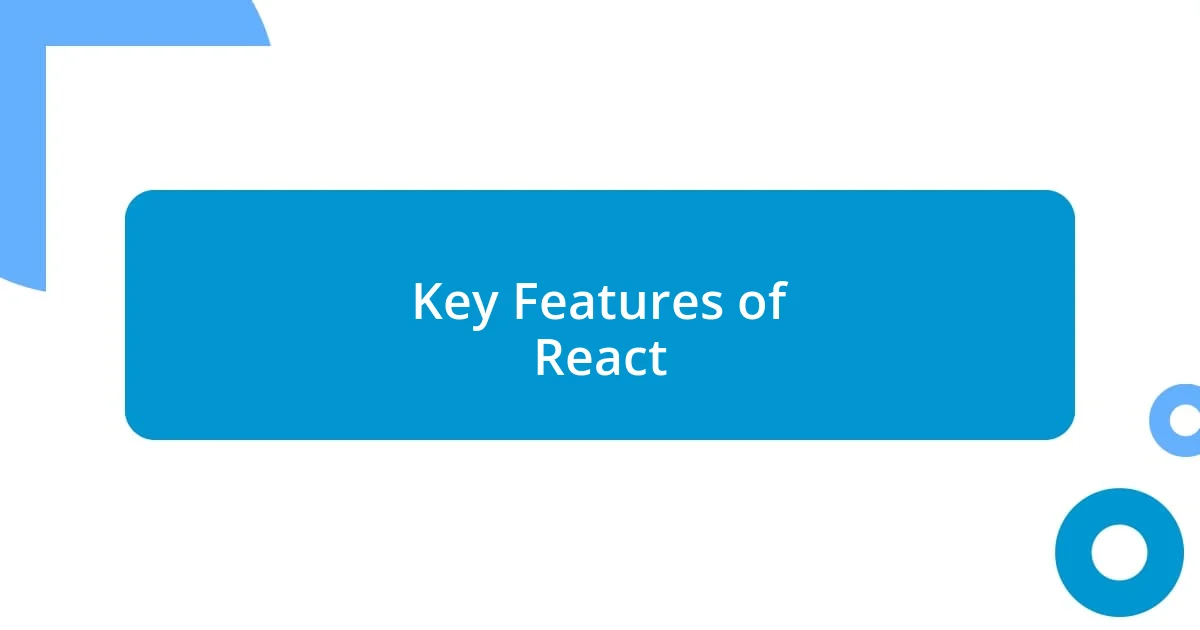
Key Features of React
React’s key features are what set it apart in the world of front-end development. One standout is its component-based architecture, which allows developers to break down complex UIs into smaller, reusable components. Reflecting on my own experiences, when I first utilized React’s components, I found it greatly enhanced my workflow—like organizing a messy drawer into labeled sections. Have you ever felt the satisfaction of cleaning up a cluttered space? That’s exactly how it felt to streamline my codebase with React.
Another distinguishing feature is the virtual DOM, which optimizes the rendering process. This means when a change occurs, only the parts of the UI that specifically need updating are re-rendered rather than the entire page. I recall a project where I witnessed a noticeable performance boost simply by switching to React; the difference was like upgrading from a flip phone to the latest smartphone. Have you experienced a similar leap in efficiency with a tool you’ve tried? It’s those little moments that remind you why you chose the tech you work with.
Lastly, React boasts a large ecosystem, including libraries like Redux for state management, which provides developers with even more functionality. My learning curve was steep initially but diving into these tools was incredibly rewarding. It felt like receiving a Swiss Army knife of solutions at my fingertips. Isn’t it empowering to have such flexibility with your development toolkit?
| Feature | Benefit |
|---|---|
| Component-Based Architecture | Promotes code reusability and better organization. |
| Virtual DOM | Enhances performance by minimizing unnecessary re-renders. |
| Large Ecosystem | Offers a multitude of libraries and tools for developers. |

Key Features of Vue
Vue’s key features really highlight its strengths and the delightful experiences I’ve had while using it. One feature I find particularly effective is the reactivity system, which automatically tracks dependencies, allowing applications to update seamlessly when data changes. I remember the first time I manipulated some data, watching as the UI transformed without me having to lift a finger—it was like magic! Have you ever been in a situation where everything just clicked into place, and you felt a rush of excitement?
Another remarkable characteristic is Vue’s single-file components, which bundle HTML, CSS, and JavaScript in a single file. This structure not only enhances readability but also significantly simplifies component management. It reminded me of putting together a puzzle where every piece has its place—everything felt organized, and I could see the entire picture come together. Isn’t it wonderful when coding can feel as satisfying as a well-functioning system?
Here are some standout features of Vue:
- Reactivity System: Automatically tracks dependencies, leading to efficient data management and re-rendering.
- Single-File Components: Combines template, script, and style sections for better organization and management.
- Flexibility: Easily integrates with other projects or libraries, allowing gradual adoption and scaling.
- Comprehensive Documentation: Offers clear, detailed guides that make learning and troubleshooting intuitive.
Every time I reach for Vue, I’m reminded of these features that not only ease development but also bring a smile to my face. It’s all about creating an enjoyable coding experience, don’t you think?
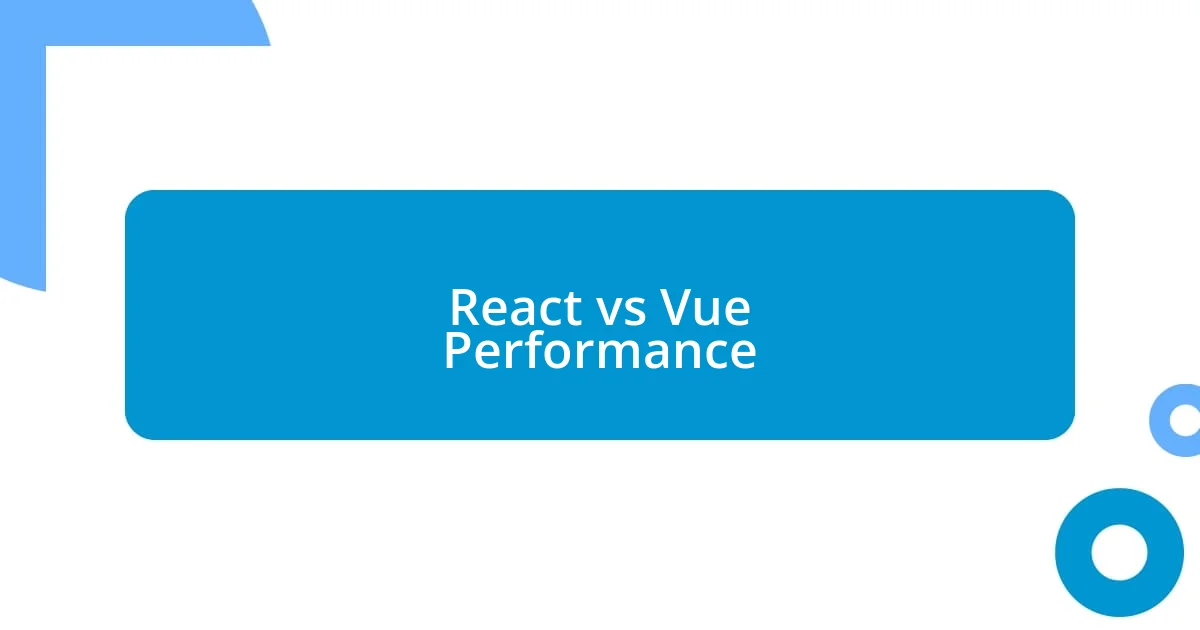
React vs Vue Performance
When comparing React and Vue, performance often hinges on how each framework manages rendering. React leverages its virtual DOM to efficiently update only the necessary components, which can lead to remarkable speed improvements. I remember diving into a project where optimizing performance became crucial; migrating from a traditional DOM structure to React’s virtual DOM felt like switching from a slow train to a fast bullet train. Have you felt that rush of adrenaline when your code finally runs smoothly?
On the other hand, Vue’s reactivity system plays a pivotal role in performance as well. It smartly tracks data changes and automatically re-renders the relevant parts of the UI. This feature reminds me of a time when I was building a dashboard; the instant updates of the UI kept me engaged, almost like watching a live scoreboard in a thrilling game. Isn’t it a delight to witness your application respond dynamically to user input without any lag?
In terms of raw performance, both frameworks shine, but the real question is how they integrate with larger applications. In my experience with heavier enterprise-level projects, I’ve found that while React’s ecosystem provides robust tools, Vue’s gentle learning curve initially eased my onboarding to performance optimizations. Have you ever chosen a tool simply because it felt more intuitive at first? Those early wins can be incredibly motivating as you embark on complex development journeys.
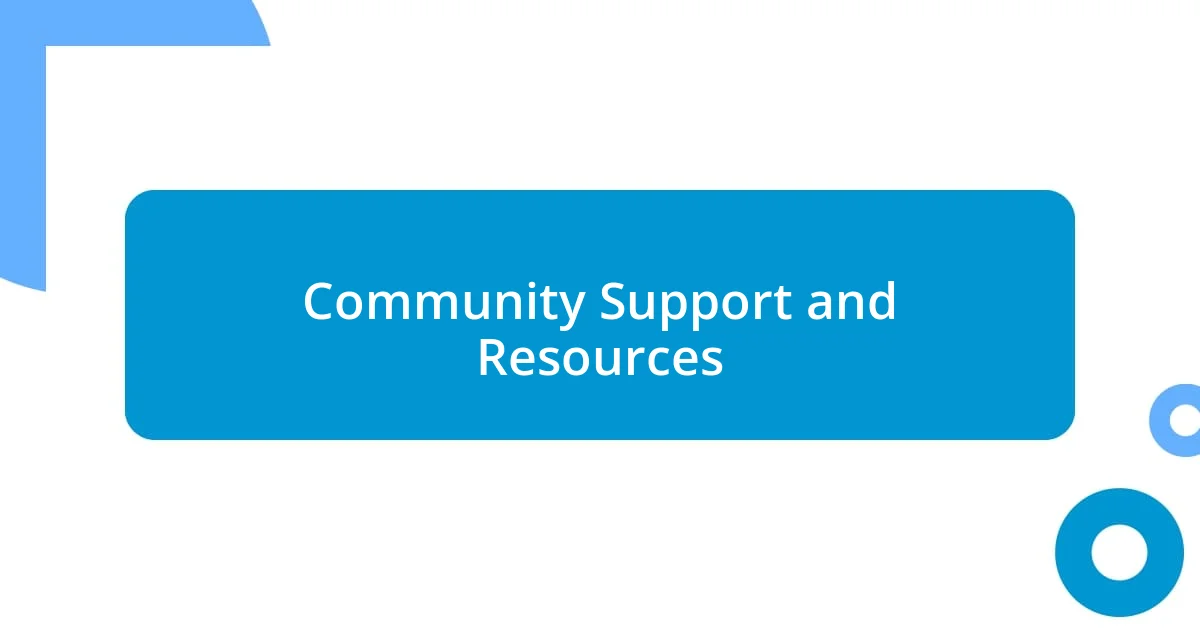
Community Support and Resources
When it comes to community support and resources, both React and Vue boast vibrant ecosystems, but I’ve often felt a particular warmth with the Vue community. It’s like joining a friendly meetup where everyone is eager to share their knowledge and offer help. I remember my first encounter at a local Vue.js event; the enthusiasm was palpable, and as I engaged with others, I left feeling more confident and connected. Have you experienced that uplifting sense of belonging in a developer community?
React, however, is backed by a robust set of resources that I truly appreciate. The extensive documentation is like a treasure chest of wisdom, and I’ve often found myself diving deep into forums like Stack Overflow. It’s where complex questions find clarity, and I recall a specific instance where an obscure bug was resolved thanks to a thoughtful response from an experienced developer. Doesn’t it feel rewarding when you finally crack that tough nut with the help of a supportive online community?
Moreover, both frameworks feature an array of resources, from tutorials and courses to GitHub repositories. I’ve often shared my own projects on platforms like CodeSandbox, where both communities come together to provide feedback. I was pleasantly surprised the first time I received constructive criticism that helped me rethink my approach. Isn’t it fascinating how collaborative efforts can lead us to unexpected improvements in our work? Whether you lean towards React or Vue, knowing there’s help available makes all the difference in your development journey.
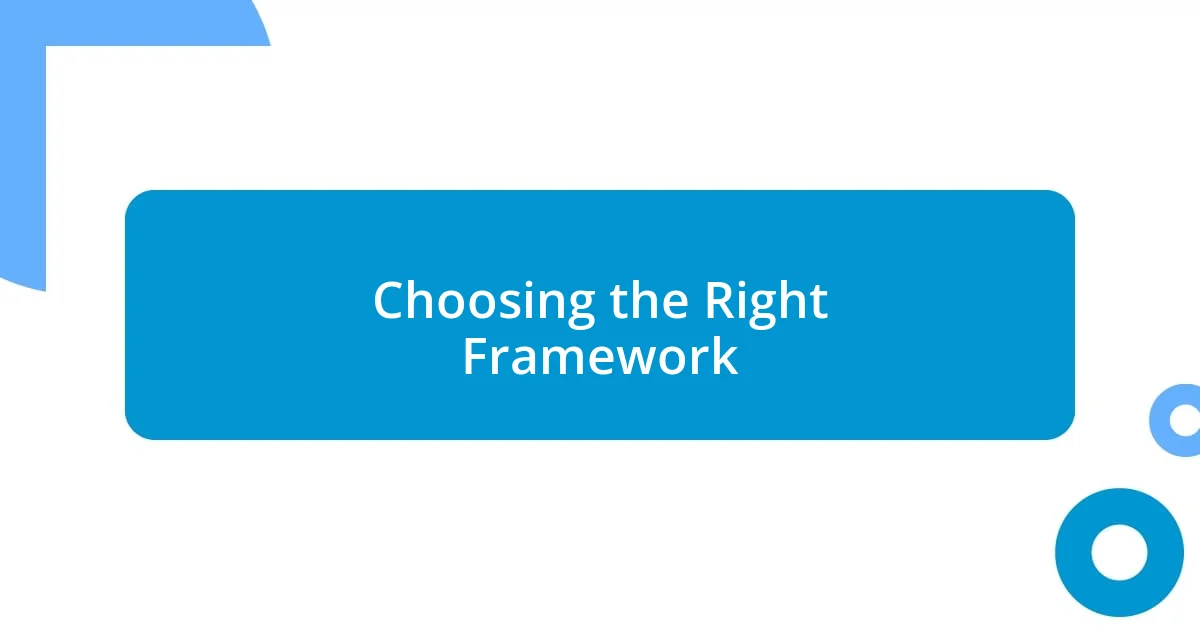
Choosing the Right Framework
Choosing between React and Vue as your framework can feel akin to picking the right tool for your unique project. I remember standing at a crossroads during a web application project, debating which path to take. React’s alluring flexibility and vast ecosystem seemed perfect for creating a highly interactive user experience, but Vue’s simplicity and intuitive design called to me. Have you ever stared at two options, each holding potential but pulling you in different directions?
What often sways my decision is the project’s complexity and team familiarity. For instance, while working on a small-scale application, I found Vue to be incredibly straightforward. Its single-file components made it easy for my team to dive in without a steep learning curve. Isn’t it a relief when you can focus on building features instead of navigating through complicated syntax? Conversely, in larger applications where scalability becomes critical, React’s component-based architecture proves advantageous.
I also think about project deadlines and team dynamics when choosing a framework. Early in my career, I led a team that required rapid development. React’s strong ecosystem and tools like Next.js furnished us with the speed we needed to meet our client’s expectations. There was a palpable sense of achievement when we delivered ahead of schedule. Have you felt that thrill when everything comes together seamlessly? In the end, your choice should reflect not just the framework’s capabilities but also how it aligns with your team’s strengths and the project’s goals.
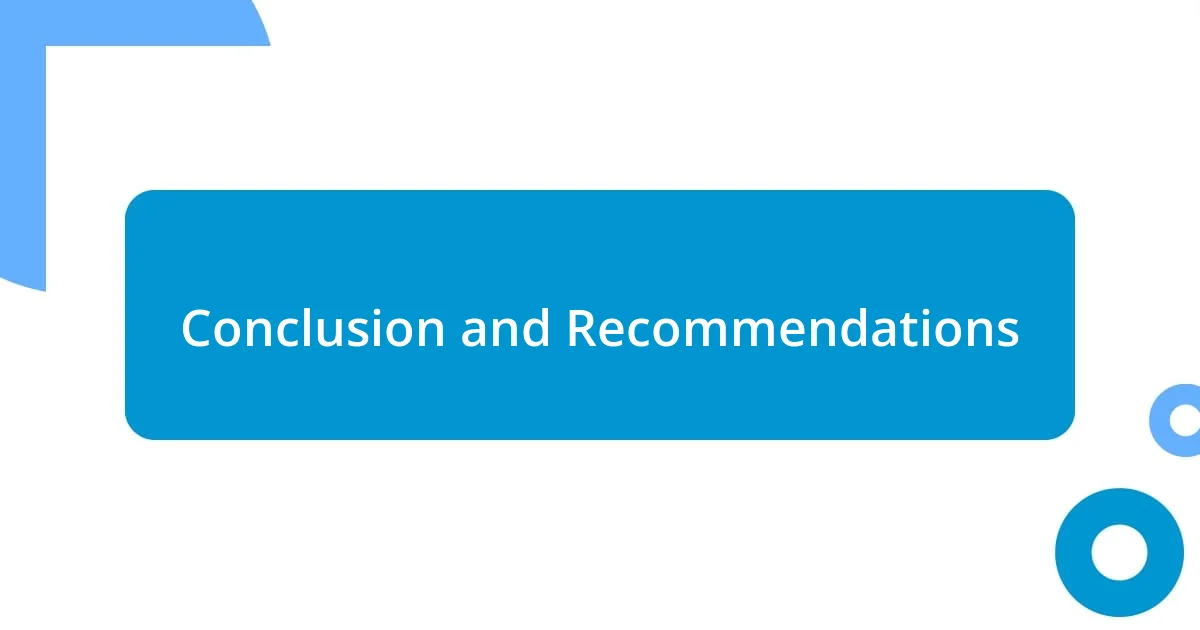
Conclusion and Recommendations
As I reflect on the journey of choosing between React and Vue, I find it essential to weigh both your project’s requirements and your personal preferences. If you enjoy hands-on control and flexibility, React might resonate with you, particularly for complex applications. I recall a project where I crafted an intricate dashboard using React; the freedom I felt to mold every component was exhilarating. Isn’t it satisfying when you can tailor a solution that fits just right?
On the other hand, if you value ease of use and a gentle learning curve, Vue could be your go-to choice. I remember diving into a side project with Vue, and the sense of flow I experienced was remarkable. The way I could quickly prototype features without wrestling with syntax was refreshing. Have you ever found yourself so immersed in your work that time just slips away? That’s the kind of magic Vue can bring, especially in smaller projects where you want to see results fast.
In conclusion, my recommendation would be to consider not only the technical specifications of each framework but also how each aligns with your working style and project needs. Take the time to experiment with both; it can be a revealing experience. I once spent a weekend building the same app in both frameworks, and it helped clarify my preferences. What about you? What will your journey reveal about your development style?














